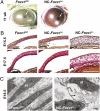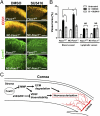Forkhead box transcription factor FoxC1 preserves corneal transparency by regulating vascular growth
- PMID: 22171010
- PMCID: PMC3277512
- DOI: 10.1073/pnas.1109540109
Forkhead box transcription factor FoxC1 preserves corneal transparency by regulating vascular growth
Abstract
Normal vision requires the precise control of vascular growth to maintain corneal transparency. Here we provide evidence for a unique mechanism by which the Forkhead box transcription factor FoxC1 regulates corneal vascular development. Murine Foxc1 is essential for development of the ocular anterior segment, and in humans, mutations have been identified in Axenfeld-Rieger syndrome, a disorder characterized by anterior segment dysgenesis. We show that FOXC1 mutations also lead to corneal angiogenesis, and that mice homozygous for either a global (Foxc1(-/-)) or neural crest (NC)-specific (NC-Foxc1(-/-)) null mutation display excessive growth of corneal blood and lymphatic vessels. This is associated with disorganization of the extracellular matrix and increased expression of multiple matrix metalloproteinases. Heterozygous mutants (Foxc1(+/-) and NC-Foxc1(+/-)) exhibit milder phenotypes, such as disrupted limbal vasculature. Moreover, environmental exposure to corneal injury significantly increases growth of both blood and lymphatic vessels in both Foxc1(+/-) and NC-Foxc1(+/-) mice compared with controls. Notably, this amplification of the angiogenic response is abolished by inhibition of VEGF receptor 2. Collectively, these findings identify a role for FoxC1 in inhibiting corneal angiogenesis, thereby maintaining corneal transparency by regulating VEGF signaling.
Conflict of interest statement
The authors declare no conflict of interest.
Figures






Comment in
-
Studies on Axenfeld-Rieger syndrome patients and mice reveal Foxc1's role in corneal neovascularization.Proc Natl Acad Sci U S A. 2012 Feb 7;109(6):1818-9. doi: 10.1073/pnas.1119291109. Epub 2012 Jan 30. Proc Natl Acad Sci U S A. 2012. PMID: 22308435 Free PMC article. No abstract available.
-
FOXC1-associated phenotypes in humans may not always exhibit corneal neovascularization.Proc Natl Acad Sci U S A. 2012 Jun 12;109(24):E1509; author reply E1510. doi: 10.1073/pnas.1204423109. Epub 2012 May 11. Proc Natl Acad Sci U S A. 2012. PMID: 22582167 Free PMC article. No abstract available.
Similar articles
-
Disruption of foxc1 genes in zebrafish results in dosage-dependent phenotypes overlapping Axenfeld-Rieger syndrome.Hum Mol Genet. 2020 Sep 29;29(16):2723-2735. doi: 10.1093/hmg/ddaa163. Hum Mol Genet. 2020. PMID: 32720677 Free PMC article.
-
Foxc1 and Foxc2 in the Neural Crest Are Required for Ocular Anterior Segment Development.Invest Ophthalmol Vis Sci. 2017 Mar 1;58(3):1368-1377. doi: 10.1167/iovs.16-21217. Invest Ophthalmol Vis Sci. 2017. PMID: 28253399 Free PMC article.
-
FoxC1-dependent regulation of vascular endothelial growth factor signaling in corneal avascularity.Trends Cardiovasc Med. 2013 Jan;23(1):1-4. doi: 10.1016/j.tcm.2012.08.002. Epub 2012 Aug 29. Trends Cardiovasc Med. 2013. PMID: 22939989 Free PMC article. Review.
-
Dysfunction of the stress-responsive FOXC1 transcription factor contributes to the earlier-onset glaucoma observed in Axenfeld-Rieger syndrome patients.Cell Death Dis. 2014 Feb 20;5(2):e1069. doi: 10.1038/cddis.2014.8. Cell Death Dis. 2014. PMID: 24556684 Free PMC article.
-
Mechanistic Insights into Axenfeld-Rieger Syndrome from Zebrafish foxc1 and pitx2 Mutants.Int J Mol Sci. 2021 Sep 16;22(18):10001. doi: 10.3390/ijms221810001. Int J Mol Sci. 2021. PMID: 34576164 Free PMC article. Review.
Cited by
-
Promoting convergence: the Phi spiral in abduction of mouse corneal behaviors.Complexity. 2015 Jan-Feb;20(3):22-38. doi: 10.1002/cplx.21562. Complexity. 2015. PMID: 25755620 Free PMC article.
-
Tissue Engineering of Axially Vascularized Soft-Tissue Flaps with a Poly-(ɛ-Caprolactone) Nanofiber-Hydrogel Composite.Adv Wound Care (New Rochelle). 2020 Jul 1;9(7):365-377. doi: 10.1089/wound.2019.0975. Epub 2020 Jun 10. Adv Wound Care (New Rochelle). 2020. PMID: 32587789 Free PMC article.
-
Studies on Axenfeld-Rieger syndrome patients and mice reveal Foxc1's role in corneal neovascularization.Proc Natl Acad Sci U S A. 2012 Feb 7;109(6):1818-9. doi: 10.1073/pnas.1119291109. Epub 2012 Jan 30. Proc Natl Acad Sci U S A. 2012. PMID: 22308435 Free PMC article. No abstract available.
-
Loss of FOXC1 contributes to the corneal epithelial fate switch and pathogenesis.Signal Transduct Target Ther. 2021 Jan 8;6(1):5. doi: 10.1038/s41392-020-00378-2. Signal Transduct Target Ther. 2021. PMID: 33414365 Free PMC article.
-
Disruption of foxc1 genes in zebrafish results in dosage-dependent phenotypes overlapping Axenfeld-Rieger syndrome.Hum Mol Genet. 2020 Sep 29;29(16):2723-2735. doi: 10.1093/hmg/ddaa163. Hum Mol Genet. 2020. PMID: 32720677 Free PMC article.
References
-
- Regenfuss B, Bock F, Parthasarathy A, Cursiefen C. Corneal (lymph)angiogenesis—from bedside to bench and back: A tribute to Judah Folkman. Lymphat Res Biol. 2008;6:191–201. - PubMed
-
- Tolentino MJ. Current molecular understanding and future treatment strategies for pathologic ocular neovascularization. Curr Mol Med. 2009;9:973–981. - PubMed
Publication types
MeSH terms
Substances
Supplementary concepts
Grants and funding
LinkOut - more resources
Full Text Sources
Other Literature Sources
Molecular Biology Databases

